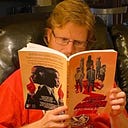People Over Politics: Rolling Blackouts and Refugees
Note: I wrote this a few years ago for my blog, but now I’m adding it to Medium for a wider audience.
A few months ago, for one of my English classes, we dove into the murky waters of refugees, examining the motive behind closing off borders and the way in which that fits or doesn’t fit American ideals (hint: I don’t think it does). The conversation quickly became pretty heated, with most of my students arguing for letting in refugees against a few very vocal opponents. I’m not going to unearth every part of that conversation, but I do want to dust off the jewel offered by one of my students who is Muslim and has family friends that are refugees — one of those family friends had her family killed by ISIS, a long cry from being an ISIS member herself.
Throughout the course of the conversation, she focused on the idea that a conversation like this quickly unfurls into abstract language, and in doing so, we lose the thread that a conversation like this should focus on: people. We should be seeing faces instead of statistics, hearts instead of hatred. Perhaps not surprisingly, my students who were against refugees sidestepped this question and continued to talk in generalizations, arguing in abstractions loosely connected with reality.
And perhaps this is the very reason that a graphic novel like Rolling Blackouts exists, a non-fiction graphic novel that follows Sarah Glidden as she journeys with journalists to Turkey, Iraq and Syria to examine refugee life. Yes, it discusses refugees who fled Iran after the US invaded (running to countries like Syria and Turkey) not refugees fleeing Syria. But, the core of the book — its attempts to anchor this abstract issue with real people and stories; its examination of what journalism is and what the responsibility of journalists should be; its insight into the impact this war had on US soldiers — all of those are not only still relevant, but even more relevant than they were in the time period this non-fiction graphic novel covers. But no matter how relevant a text is, people will throw it aside if it’s not any good. Fortunately, that’s not the case: Glidden has a subtle, yet effective, sense of structure, of how much detail to include in a panel (her cartooning style is simple, warm and enormously effective), of how much exposition to give so it informs rather than weighs down the story.
The graphic novel expertly shows that refugees are people, but that doesn’t mean it glorifies them to sainthood. No, it means that it shows them with their hopes and fears, their successes and failures. For example, we visit with refugees who were formerly middle class, mainly concerned about their children’s ability to go to college and live a better life. That’s not too far from the American Dream, but then again, the US doesn’t hold a monopoly on the idea that children should become more successful than their parents. At the same time, we see refugees who harbor a lot of hatred towards the American government, although this hatred that doesn’t prevent them from dealing with Americans kindly, realizing they don’t can’t treat a person as a generalized group…if only we had the same compassion and curiosity.
If this piece of graphic journalism only concerned itself with removing the blinders that prevent people from truly seeing refugees as people, it would be a powerful work of art. But Glidden doesn’t stop there. As in the real-world, one topic can’t be separated completely from the rest: each person and event is connected by silken strands to others in the web. And it’s almost impossible to talk about refugees without talking about the role of media in their story and the role that US soldiers played in their exile. Although Glidden is not a journalist by trade, she reports these scenes with so much objectivity and emphasis on relevance that one could almost believe she is working from the same cook book that journalists use. Glidden knows how to balance ingredients so that one taste doesn’t overpower. She knows how to make them gel into something greater than the individual parts, much like a cake is greater than an egg or butter.
And this journalistic instinct also serves her well when turning to the subject of journalism itself. Glidden focuses on the controversial parts of journalism — the commercialization of it as industry, the need to keep audience reaction in mind when shaping a story, the at-times naive ambitions that let journalists see themselves as an authority on objective reality. These snapshots of the challenges of journalism combine with the images of journalists acting nobly to create a collage that dazzles in its complexity.
The final piece Glidden adds to this story also creates further complexity. A US soldier who had tours in Iraq is along for the ride, giving his perspective on these issues. While he spends most of the novel touting the company line, toward the end of the work, we start to see more nuance to those feelings. But that nuance doesn’t mean the soldier switches perspectives and denounces the war. Instead, it just means that his conflicting emotions are finally brought to light without any resolution, which is more realistic than the Hollywood ending the journalists themselves might have been hoping for.
With President Trump’s recent ban on refugees there has never been a better time to study this topic. And what better way to do that then with a graphic novel that is informative in its simplicity, thought-provoking in its complexity, and defiant in its belief in the human heart, whether that heart was born American or not.
